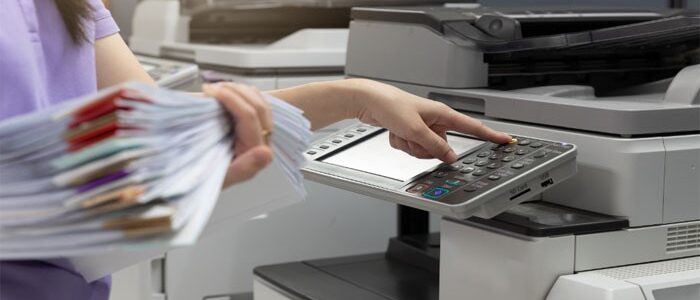
How the photocopier transformed the office
The photocopier is something we all take for granted in the modern workplace but it transformed offices in the 1950s – and with advances in technology during the 20th century, the prototype for the first 3D printer was developed in the 1980s.
Before the advent of the photocopier, relaying information to multiple employees was an arduous task for office staff. When an important letter arrived, or an important document had to be circulated, only a small number of managers were likely to see it.
The original was circulated from office to office and everyone who had read it had to sign a “routing slip”. This confirmed it had been seen and indicated where it should go next.
Carbon paper was also used by typists, or for hand-written documents, but the copies weren’t sharp and were often smudged.
Once the photocopier arrived, employees could copy anything that they felt other staff needed to see. Convenient and efficient, it transformed the way knowledge flowed in the company.
When was the photocopier created?
The technology on which the modern photocopier was based was invented in 1938 by Chester Carlson, an American physicist and former student of the California Institute of Technology. He originally called the process electrophotography, although it later became known as the xerographic process.
Working for a printing firm, he had this in mind when he designed his xerographic process. While still at school, he had published his own newspaper, called This and That, as he had always been interested in the print industry.
In October 1948, the Haloid Company began producing the first photocopier based on xerography. One year on, it despatched the first commercial photocopier, the Xerox Model A Copier.
In 1958, the company changed its name to Haloid Xerox.
Which was the first modern photocopier?
The first truly modern photocopier was the Xerox 914, which was introduced to the market in September 1959, when it was demonstrated at the Sherry Netherland Hotel in New York. It became hugely successful and almost doubled Haloid Xerox’s revenue between 1959 and 1961. The company then became known as the Xerox Corporation.
As well as revolutionising the way offices were run, by making it much easier to convey information to all staff in these pre-email days, the photocopier was also popular in certain sectors. Artists were fond of the device, as it produced high-contrast prints that were unlike traditional printing or photographs.
One artist who became famous for using a photocopier was the American writer Pati Hill, who used an IBM photocopier to produce unusual prints. She would photocopy an inanimate object in such a way that it appeared to be some mystical photograph – such as a hair curler that looked like a space ship and the inside of a straw hat that appeared to be a descent into a volcano.
The photocopier was also widely used in publishing and was used to circulate ideas among employees that might not have got past the editor in the past. In 1966, xerography was described as bringing a “reign of terror” into the publishing world, because anyone could write and distribute copy.
How have photocopiers changed?
Since the first modern photocopiers appeared in the 1950s, the technology has saved time for office workers, without making their role obsolete. The basic operating principle of photocopiers has remained the same, with the technology transferring to printers and scanners as well.
Perhaps the most significant advance has been the invention of 3D photocopiers. The earliest record of 3D printing was when Japanese inventor Hideo Kodama invented a machine in 1981 that used ultraviolet light to create solid objects by hardening polymers. This was the steppingstone to stereolithography – the technology that led to today’s 3D printers.
Charles “Chuck” Hill invented stereolithography – a process that creates solid objects that are printed, layer by layer. Computer-aided designs (CAD) are used to design the 3D models.
Selective Laser Sintering is a more advanced type of 3D printing, using a powder polymer, such as nylon, to create objects. A laser fuses the powder together in layers that form all kinds of complex shapes.
The most common type of 3D printing today is Fused Deposition Modelling, developed by Scott Crump. Labelled the “desktop 3D printer”, it forms an object by heating a cable of thermoplastic into liquid form and printing it in layers. People can make almost anything now by creating a computer file and printing it off.
It’s hard to imagine today’s workplace without a photocopier, be that traditional offices or coworking space.
© Jat306 / Shutterstock.com


